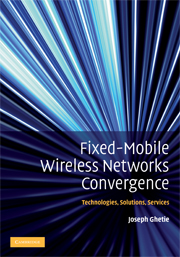Book contents
- Frontmatter
- Contents
- Disclaimer
- How the Book is Organized
- List of Figures
- List of Tables
- Preface
- Acknowledgments
- Acronyms
- Part I Wireless Communications: Networking and Management
- Part II Cellular Mobile Radio Networking and Management
- Part III Fixed Wireless Technologies: Networking and Management
- Part IV Fixed Wireless Cellular Mobile Networks Convergence and Integration
- Part V Fixed Wireless Cellular Mobile Networks Convergence: Standardized Networking Solutions
- 15 UMA-based Fixed Wireless and Cellular Mobile Networking Solutions and Products
- 16 Session Initiation Protocol
- 17 IMS-based Fixed Wireless and Cellular Mobile Networking Solutions and Products
- Part VI Fixed-Mobile Convergence Services, Industry Trends, and Implementation Issues
- References
- Index
17 - IMS-based Fixed Wireless and Cellular Mobile Networking Solutions and Products
from Part V - Fixed Wireless Cellular Mobile Networks Convergence: Standardized Networking Solutions
Published online by Cambridge University Press: 21 August 2009
- Frontmatter
- Contents
- Disclaimer
- How the Book is Organized
- List of Figures
- List of Tables
- Preface
- Acknowledgments
- Acronyms
- Part I Wireless Communications: Networking and Management
- Part II Cellular Mobile Radio Networking and Management
- Part III Fixed Wireless Technologies: Networking and Management
- Part IV Fixed Wireless Cellular Mobile Networks Convergence and Integration
- Part V Fixed Wireless Cellular Mobile Networks Convergence: Standardized Networking Solutions
- 15 UMA-based Fixed Wireless and Cellular Mobile Networking Solutions and Products
- 16 Session Initiation Protocol
- 17 IMS-based Fixed Wireless and Cellular Mobile Networking Solutions and Products
- Part VI Fixed-Mobile Convergence Services, Industry Trends, and Implementation Issues
- References
- Index
Summary
What is the IP-based Multimedia Subsystem?
The IP-based Multimedia Subsystem (IMS) is the Next Generation Network (NGN) architecture, set of components, and interface specifications that allow convergence of wired and wireless networks. Convergence/integration of fixed and mobile wireless networks, the subject of this book, is part of the broader convergence just defined. The IMS convergent network will emerge from an Internet Protocol (IP)-based network infrastructure and a common service platform, allowing the development of a large array of telecommunications and multimedia applications. IMS is a user/operator-centric architectural framework that shifts much of its intelligence to the network periphery. Users of IMS services will benefit because of full mobility and service transparency across all networks.
IMS development was initiated in 1999 by a group of leading mobile service providers in conjunction with the promotion of future generations of mobile networks. This work was taken over by the 3G Partnership Project (3GPP) and presented for the first time in 3GPP Release 5 (3GPP R5) specifications. Release 5 was augmented by the addition, in Release 6 (3GPP R6), of the Internet Engineering Task Force (IETF) Session Initiation Protocol (SIP). In 3GPP Release 7, IMS incorporated the NGN concepts promoted by the European Telecommunications Standard Institute's (ETSI) Telecommunications and Internet Converged Services and Protocols for Advanced Networking (TISPAN) division. Also, the mobile networks support for IMS was extended from GSM/UMTS to CDMA2000 through 3GPP2 working specifications.
- Type
- Chapter
- Information
- Fixed-Mobile Wireless Networks ConvergenceTechnologies, Solutions, Services, pp. 324 - 352Publisher: Cambridge University PressPrint publication year: 2008



